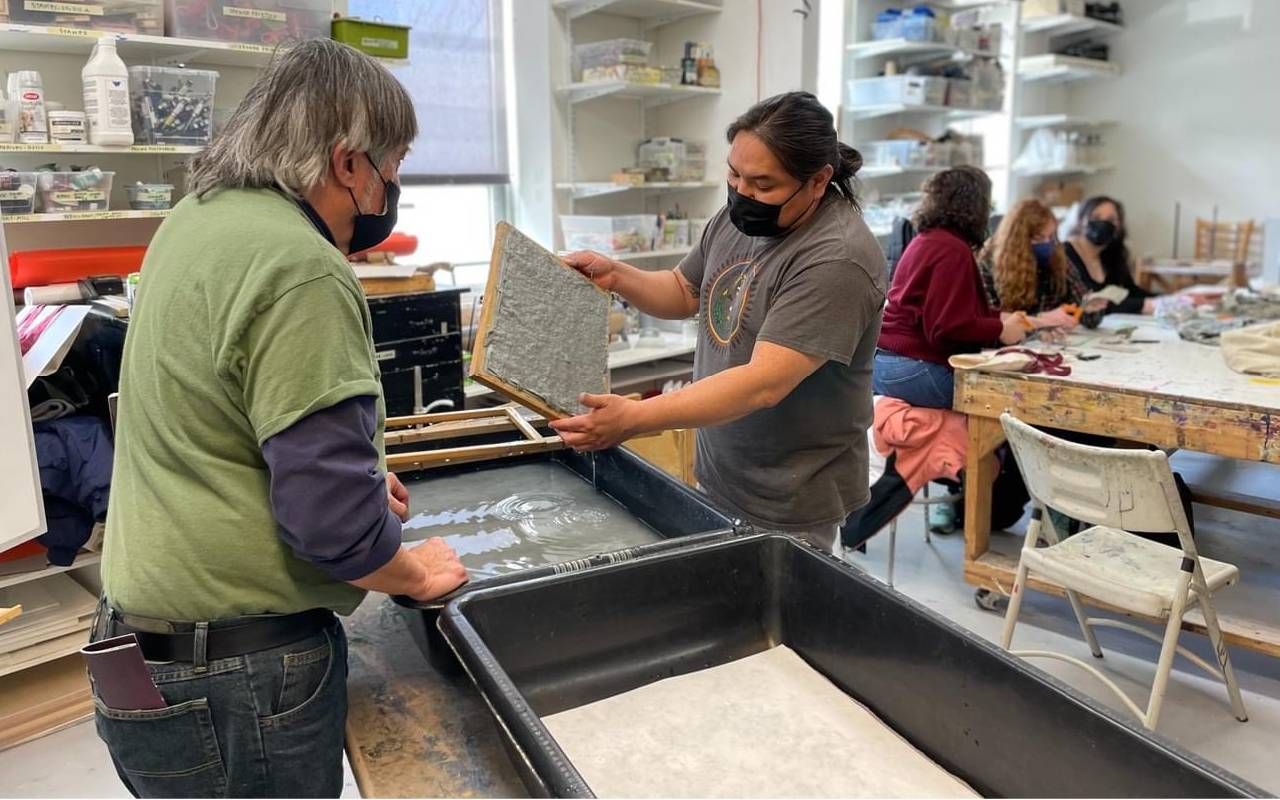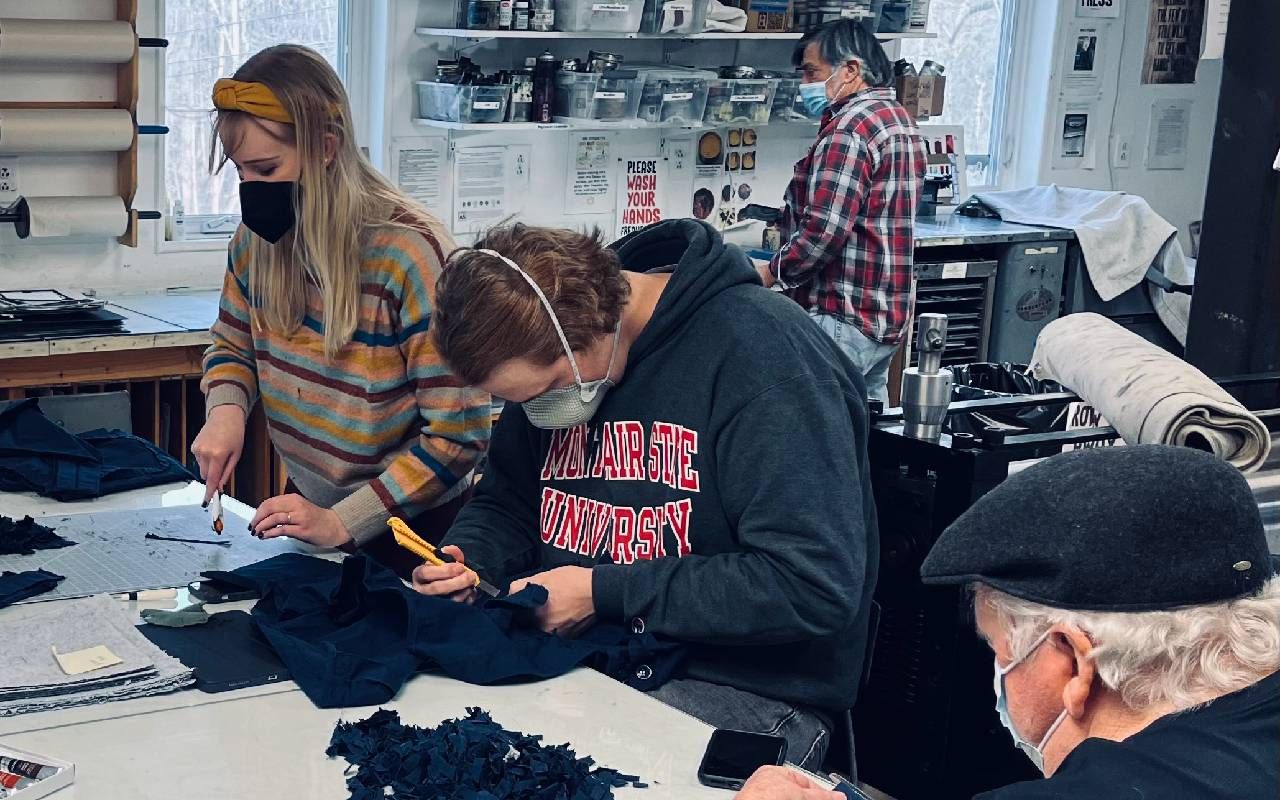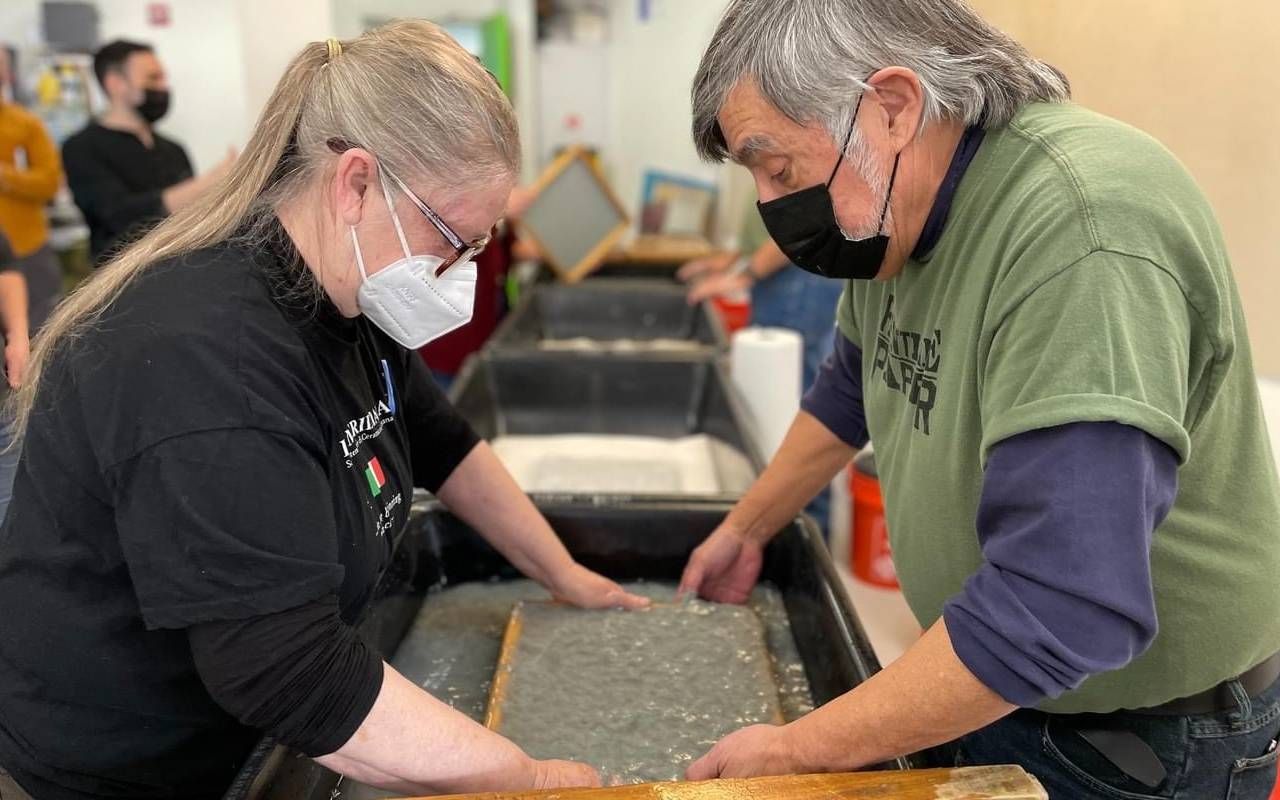Transforming Military Uniforms Into Paper Art Can Bring Healing
In a holistic process, veterans take uniforms and transform them into paper art while sharing memories, building camaraderie and addressing emotional trauma
Once they were uniforms, worn by military personnel who fought in Iraq, Afghanistan, Vietnam, even in the Korean War. There are the Army's Standard Woodland Battle Dress Uniforms (BDUs), and others have operational camouflage patterns, so troops in desert or wooded settings cannot be visualized by the enemy. Some of the uniforms, shockingly, have bullet holes embedded in the material.

Now, in a number of programs around the country, these military uniforms, stained with blood, sweat and tears, are being transformed into paper.
These workshops become an environment that promotes healing, health and community.
Veterans, many of whom have returned home bruised, battered and traumatized, gather together in day or weeklong workshops, making paper while processing their experiences, sharing memories, regrets and moments of laughter and camaraderie. These workshops become an environment that promotes healing, health and community.
Military uniforms have great psychological and symbolic meanings, as do the insignias, Combat and Special Skills Patches and even the reverse flag patch worn on some soldier's right shoulders. The Army says that "Our uniforms embody the professionalism and commitment to the Army values – loyalty, duty, respect, selfless service, honor, integrity and personal courage. The uniform is a symbol of honor and tradition, of esprit de corps and morale, and of personal excellence and pride."
The Symbol of the Uniform
In her 2016 book "Grunt: The Curious Science of Humans at War," Mary Roach describes a Textile Performance Test Facility, where factors such as moisture management, flame resistance and ability to be made repellant to insects are integral parts of uniform design.
"If possible, the army would like to dress its men and women in uniforms that protect them against all that modern warfare has to throw at them: flames, explosives, bullets , lasers, bomb-blasted dirt, blister agents, anthrax, sand fleas," she writes, adding that "They would like these same uniforms to keep soldiers cool and dry in extreme heat, to stand up to the ruthless rigors of the Army field laundry, to feel good against the skin, to look smart, and to come in under budget."
Frontline Paper, the flagship program of Frontline Arts, is a fifty-year old New Jersey-based, non-profit arts organization whose mission is to connect and build communities through socially engaging arts practices rooted in papermaking and printmaking.
"We don't call our programs therapy or art therapy because labeling it in that way would be the best way to keep veterans away."
Through what the program describes as a "transformational process of Deconstruction, Reclamation and Communication," veteran artist instructors teach participants to create handmade paper from military uniforms. After the uniforms are shredded into postage stamp-sized pieces, Hollander beaters are used to turn the fabric into paper pulp which ultimately become sheets of paper that can be used alone or as the background for etchings, collage, journals or screen printing.
Participants may use rank insignias and name tags from their uniforms to create uniquely personalized pieces. While working on their art or socializing before and after the workshops, veterans share their memories of what they experienced while on active duty, and, sometimes, their feelings about what their uniforms represent.
Ron Erickson, a Tokyo-born fine artist and carpenter who served in the Marine Corps from 1982-1985, has been the program manager for Frontline Paper/Frontline Arts since 2019 and also serves as an assistant instructor in workshops.
"We don't call our programs therapy or art therapy because labeling it in that way would be the best way to keep veterans away," Erickson explains. "Men in particular tend to get defensive and self-protective when we feel threatened, such as when we're being asked to talk about our feelings or show our vulnerability. By nature, we walk around with our chests out."
Clearly though, these workshops are therapeutic, particularly in five-day workshops, which often include writing prompts along with papermaking, printmaking and bookmaking. He says, "We're encouraging vets to look at who they are now, who they were before they went to war, and what they need to do to become who they want to be. This is a holistic process."
The facilitators (who receive some training but who are not mental health professionals) must be careful to try to avoid controlling the speaker's narrative, even if it is different from what their own might be. As Erickson points out, "These are men and women who volunteered their lives for their country. Most are proud of their service but are not always proud of what they had to do in war. We follow orders and moral injury is rampant."

Moral injury, a complex emotional reaction to trauma, can result from someone behaving in a way that is counter to their moral beliefs, often when there are few or no other options.
Emotional Reactions
In these workshops, a cornucopia of emotions may be expressed – perhaps rage, perhaps grief, often cynicism. There is, very occasionally, a fist slammed against a table. But strong emotions are best expressed with the scissors – cutting, ripping, shredding the fabric and "liberating rag" as veteran papermakers refer to the cathartic process. And at the end of the workshop, there is paper, sometimes lots and lots of paper, perhaps edged with deckle, imbued with memories and flecks of Army green or the blue green of scrubs worn in military hospitals.
Side by side with cynicism and anger, there is also laughter and nostalgia and reminiscence about wartime buddies and pride in having served one's country. There are vets who have strong anti-war feelings and others who honor their uniforms and make paper as a way to commemorate their service. There is room for all to own their experience and to heal in whatever way they can.
"Art making provides a safe means for expressing and communicating traumatic experiences which often cannot be reconciled through verbal language."
Frontline Arts says that bringing the practice of community-based art making and storytelling to the public, with workshops and presentations that involve civilians as well as veterans, "exposes the true complexity of the veteran experience, sparking a dialogue of what it means to serve in the military and live through the aftermath."
Workshops are held in a variety of settings, with the paper, journals, booklets and prints that are created being displayed in community centers, nonprofit organizations, Veterans' centers and on college campuses across the country.
Another program, the Combat Paper Project, founded in 2007 by Drew Francis Cameron and Drew Matott in Burlington, Vermont, is now known as Combat Paper and is headed by Cameron, a former sergeant in the US Army Field Artillery and an Iraq war veteran now living in Iowa City.
For seventeen years, Cameron, whose work blends traditional papermaking with a contemporary printing technique described as "pulp printing," has traveled across the country as the principal artist of Combat Paper. He has used collaborative art making to facilitate interactions between veterans and civilians and has presented open enrollment public events and interactive sessions at universities and Veterans Resource Centers.
Papermaking as Art Therapy
Matott left the Combat Paper Project to explore papermaking as art therapy. His MFA thesis focused on papermaking as a part of the socially engaged antiwar movement, and he went on to develop The Peace Paper Project, an international community arts initiative which he now co-directs with Cleveland based art therapist Gretchen Miller.

The Peace Paper Project utilizes papermaking and other art-making activities as a vehicle for people affected by trauma to process memories and emotion through symbolic expression, and programs are facilitated by licensed professionals. Matott has art studios in both upstate New York and in Hamburg, Germany and heads this organization which trains art therapists and other professionals to work with the veteran population.
Miller says, "Art making provides a safe means for expressing and communicating traumatic experiences which often cannot be reconciled through verbal language."
As Erickson says, "The trauma that has been suffered won't go away but we hope that by expressing themselves, sometimes with words but often just by engaging with the art itself, our veterans will develop tools to take home with them to better manage their feelings. I want people to come to peace with themselves and to find their place in the world."


